Similar presentations:
Lecture B6: DNA Replication, Transcription and Translation
1. Lecture B6: DNA Replication, Transcription and Translation
Foundation Year ProgramLecture B6:
DNA Replication,
Transcription and Translation
Introduction to Biology
2019-20
2. Learning Outcomes
Foundation Year ProgramLearning Outcomes
At the end of the lecture students should be able to:
• Describe the process of DNA replication
• Explain the relationship between the processes of
DNA transcription, RNA processing and protein
synthesis
• Text reference: Campbell Concepts, 10.4-10.15
Introduction to Biology
2019-20
3. DNA and genetics
Foundation Year ProgramDNA and genetics
• Genetics is the study of inheritance – how
characteristics are passed from parents to
offspring
• The hereditary information is encoded in DNA
and passed from one generation to the next
by precise copying
• Because of this DNA is frequently referred to
as the “genetic molecule”
Introduction to Biology
2019-20
4. DNA replication
Foundation Year ProgramDNA replication
• DNA replication is the biological process of
producing two identical copies (replicas) of DNA
from one original DNA molecule
• Necessary precursor to cell division (next lecture)
Introduction to Biology
2019-20
5.
Foundation Year ProgramDNA replication is semiconservative
Introduction to Biology
2019-20
6. DNA replication is semiconservative
Foundation Year ProgramDNA replication
Introduction to Biology
2019-20
7.
Foundation Year ProgramDNA replication proceeds in two
directions at many sites simultaneously
• Replication of a DNA molecule begins at sites
called origins of replication, short stretches of
DNA that have a specific sequence of
nucleotides.
• Proteins that initiate DNA replication attach to
the DNA at the origin of replication and
separate the two strands of the double helix
• Replication then proceeds in both directions,
creating replication “bubbles.”
Introduction to Biology
2019-20
8. DNA replication proceeds in two directions at many sites simultaneously
Foundation Year ProgramIntroduction to Biology
2019-20
9.
Foundation Year ProgramEnzymes involved in replication
• DNA polymerases add
nucleotides to the
growing strands
• DNA ligase ties short
DNA fragments
together
• DNA polymerases and
DNA ligase also repair
DNA damaged by
harmful radiation and
toxic chemicals
Introduction to Biology
2019-20
10. Enzymes involved in replication
Foundation Year Program• DNA replication ensures that all the somatic
cells in a multicellular organism carry the
same genetic information
• If the process is completed without errors,
two daughter cells identical to the original will
form.
• However, mistakes may occur during this
complicated process – these can result in
mutations
Introduction to Biology
2019-20
11.
Foundation Year ProgramGene expression
Introduction to Biology
2019-20
12. Gene expression
Foundation Year ProgramGene expression
• The expression of the information encoded in
DNA is a complicated, multi-step process
• The DNA program ultimately directs the
development of biochemical, anatomical and
physiological traits of the cell and individual
Introduction to Biology
2019-20
13. Gene expression
Foundation Year ProgramThe flow of information is from
DNA to RNA to protein
• DNA specifies traits by dictating protein
synthesis.
• The molecular chain of command is from DNA
in the nucleus to RNA and RNA in the
cytoplasm to protein.
Introduction to Biology
2019-20
14. The flow of information is from DNA to RNA to protein
Foundation Year ProgramGenes control characteristics
through the production of proteins
• Transcription is
the synthesis of
messenger RNA
(mRNA) using DNA
as a template.
• Translation is the
synthesis of
proteins under the
direction of
mRNA.
Introduction to Biology
2019-20
15. Genes control characteristics through the production of proteins
Foundation Year ProgramTranscription and Translation
Introduction to Biology
2019-20
16. Transcription and Translation
Foundation Year ProgramTranscription
Introduction to Biology
2019-20
17. Transcription
Foundation Year ProgramTranscription produces mRNA
• Transcription of a gene occurs in three main steps:
1. Initiation: RNA polymerase attaches to a DNA region
called the promoter and starts RNA synthesis
2. Elongation: The newly formed RNA strand grows
3. Termination: The RNA polymerase reaches the
terminator DNA and detaches from both the newly
made RNA transcript and the DNA
Introduction to Biology
2019-20
18. Transcription produces mRNA
Foundation Year ProgramThe transcription of a gene
Introduction to Biology
2019-20
19. The transcription of a gene
Foundation Year ProgramPost-transcriptional modification
• In prokaryotes, the RNA transcript is ready for
immediate translation
• Eukaryotic mRNA is more complex than
prokaryotic
– Contains introns (interrupting sequences)
that separate exons (the coding regions)
• It is processed in the nucleus and then
exported for translation
Introduction to Biology
2019-20
20. Post-transcriptional modification
Foundation Year ProgramEukaryotic RNA processing
• First there is RNA splicing
– Introns are removed and the exons are joined to
produce a continuous coding sequence.
• Then a cap and tail of extra nucleotides are added to the
ends of the mRNA to:
– Help the export of the mRNA from the nucleus
– Protect the mRNA from degradation by cellular enzymes
– Help ribosomes bind to the mRNA
• The cap and tail are not translated into protein.
Introduction to Biology
2019-20
21. Eukaryotic RNA processing
Foundation Year ProgramProduction
of
eukaryotic
mRNA
Introduction to Biology
2019-20
22. Production of eukaryotic mRNA
Foundation Year ProgramTranslation
Introduction to Biology
2019-20
23. Translation
Foundation Year ProgramInformation written in DNA is
translated into proteins
• The sequence of nucleotides in DNA provides a
code for constructing a protein
– This requires a conversion of a nucleotide
sequence to an amino acid sequence
• The flow of information from gene to protein is
based on a triplet code – three-base “words”
called codons
Introduction to Biology
2019-20
24. Information written in DNA is translated into proteins
Foundation Year ProgramThe genetic code dictates how codons are
translated into amino acids
• The genetic code directs the amino acid
translation of each of the nucleotide triplets.
– Three nucleotides specify one amino acid.
– Of the possible 64 codons, 61 code for amino
acids and 3 codons signal the end of translation.
– AUG codes for methionine and signals the start of
translation.
– UAA, UGA and UAG are the stop codons.
Introduction to Biology
2019-20
25. The genetic code dictates how codons are translated into amino acids
Foundation Year ProgramDictionary of the
genetic code
Introduction to Biology
2019-20
26. Dictionary of the genetic code
Foundation Year ProgramCharacteristics of the genetic code
• The genetic code is
– Redundant: some amino acids have more than one
codon
– Unambiguous: each codon codes for only one amino
acid
– (Nearly) universal: the genetic code is shared by
organisms from the simplest bacteria to the most
complex plants and animals
Introduction to Biology
2019-20
27. Characteristics of the genetic code
Foundation Year ProgramTranslation of the genetic message
• Translation is performed by transfer RNA
(tRNA) molecules
• Transfer RNA molecules do this by
– picking up the appropriate amino acid
– using a special triplet of bases, called an
anticodon, to recognize the appropriate codons in
the mRNA.
Introduction to Biology
2019-20
28. Translation of the genetic message
Foundation Year ProgramA simplified
representation of a
tRNA
Introduction to Biology
2019-20
29.
Foundation Year ProgramRibosomes build polypeptides
• Translation occurs on the surface of the ribosome.
– Ribosomes coordinate the interaction of mRNA and
tRNA and, through this, the synthesis of polypeptides.
• Ribosomes have two subunits: small and large.
• Each subunit is composed of ribosomal RNAs (rRNA) and
proteins.
• Ribosomal subunits come together during translation.
• Ribosomes have binding sites for mRNA and tRNAs.
Introduction to Biology
2019-20
30. Ribosomes build polypeptides
Foundation Year ProgramTranslation produces polypeptides
• Translation can be divided into the same three
phases as transcription:
1. Initiation
2. Elongation
3. Termination
Introduction to Biology
2019-20
31. Translation produces polypeptides
Foundation Year ProgramAn initiation codon marks the start
of the mRNA message
• Initiation brings together
– mRNA, a tRNA bearing the first amino acid, and the
two subunits of a ribosome.
– Initiation establishes where translation will begin.
Cap
End
Start of genetic
message
Introduction to Biology
Tail
2019-20
32. An initiation codon marks the start of the mRNA message
Foundation Year ProgramThe two stages of initiation in
translation
2. A large ribosomal subunit joins
1. mRNA binds to a small
the small subunit, allowing the
ribosomal subunit, and an
initiator tRNA binds to mRNA at ribosome to function.
the start codon that reads AUG • The first tRNA occupies the P site
and codes for methionine (first (growing polypeptide).
tRNA has the anticodon UAC). • The A site (next amino-acidbearing tRNA).
Introduction to Biology
2019-20
33. The two stages of initiation in translation
Foundation Year ProgramRibosomes with
unoccupied and
occupied binding
sites
Introduction to Biology
2019-20
34. Ribosomes with unoccupied and occupied binding sites
Foundation Year ProgramElongation adds amino acids to the
polypeptide chain
• Once initiation is complete, amino acids are added one
by one to the first amino acid (elongation process).
• This occurs in three steps:
1. The anticodon of an incoming tRNA molecule, carrying its
amino acid, pairs with the mRNA codon in the A site of the
ribosome.
2. The polypeptide separates from the tRNA in the P site and
attaches by a new peptide bond to the amino acid carried
by the tRNA in the A site.
3. The P site tRNA (now lacking an amino acid) leaves the
ribosome, and the ribosome translocates (moves) the
remaining tRNA (which has the growing polypeptide) from
the A site to the P site.
Introduction to Biology
2019-20
35. Elongation adds amino acids to the polypeptide chain
Foundation Year ProgramTranslationElongation adds
amino acids to
the polypeptide
chain
Reminder:
A-site: Amino acid
P site: polypeptide
Introduction to Biology
2019-20
36. Translation- Elongation adds amino acids to the polypeptide chain
Foundation Year ProgramElongation adds amino acids to the polypeptide
chain until a stop codon terminates translation
Release
factor
Free
polypeptide
5
3
5
5
Stop codon
(UAG, UAA, or UGA)
3
2
3
GTP
2 GDP
Campbell Biology, 9th ed.
Stop codon comes into A site
Release factor binds
Energy input
The ribosome splits back into its separate subunits
New protein is released
Introduction to Biology
2019-20
37. Elongation adds amino acids to the polypeptide chain until a stop codon terminates translation
Foundation Year ProgramSummary
• Genes are expressed when DNA directs protein
synthesis
• During gene expression, DNA is transcribed to
mRNA, which is then translated to protein
• Transcription in eukaryotes happens in the nucleus
• Translation is carried out by the ribosomes
Introduction to Biology
2019-20
38. Summary
Foundation Year ProgramAnimation: Transcription
Introduction to Biology
2019-20
39. Animation: Transcription
Foundation Year ProgramAnimation: Translation
Introduction to Biology
2019-20
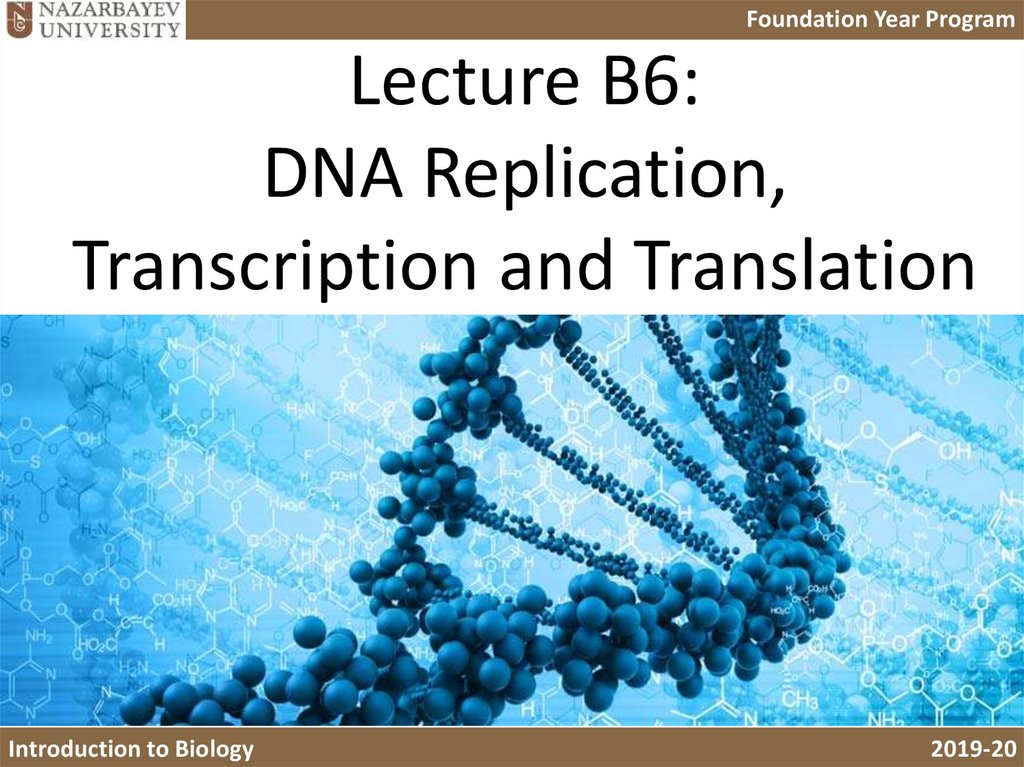

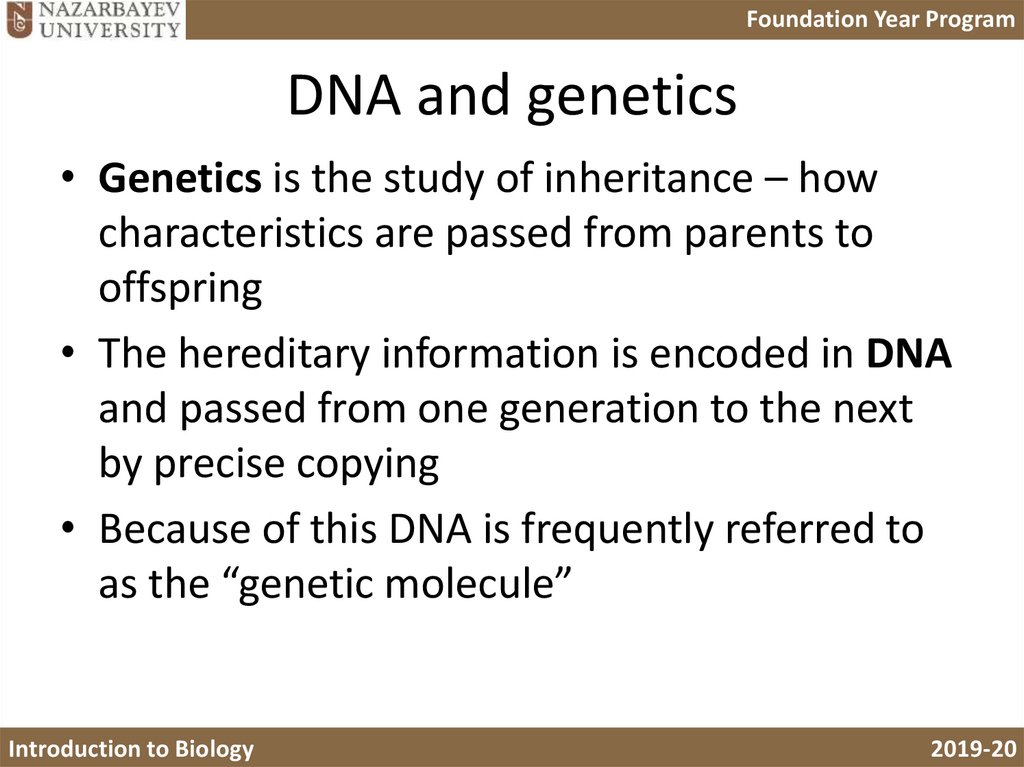

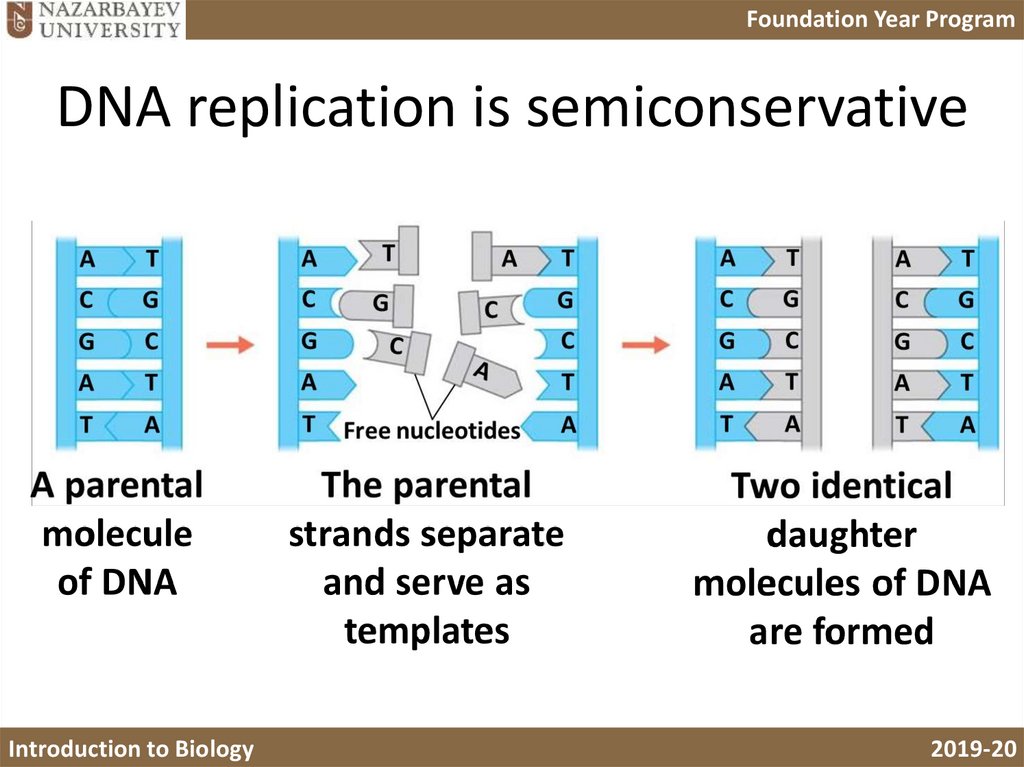
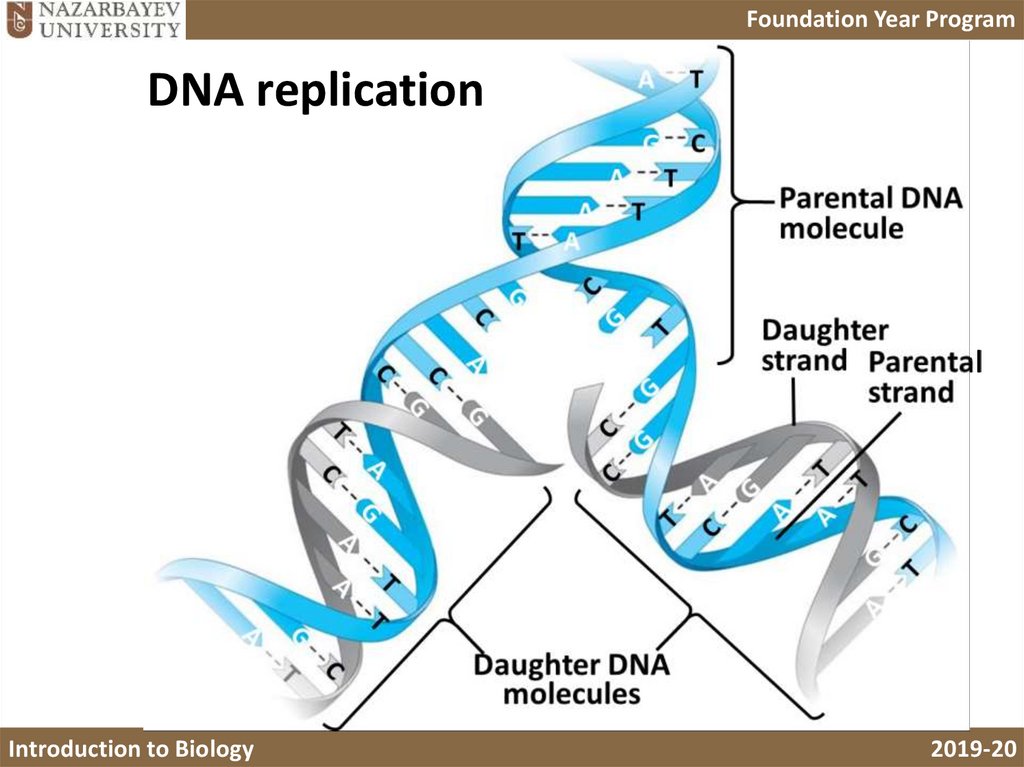
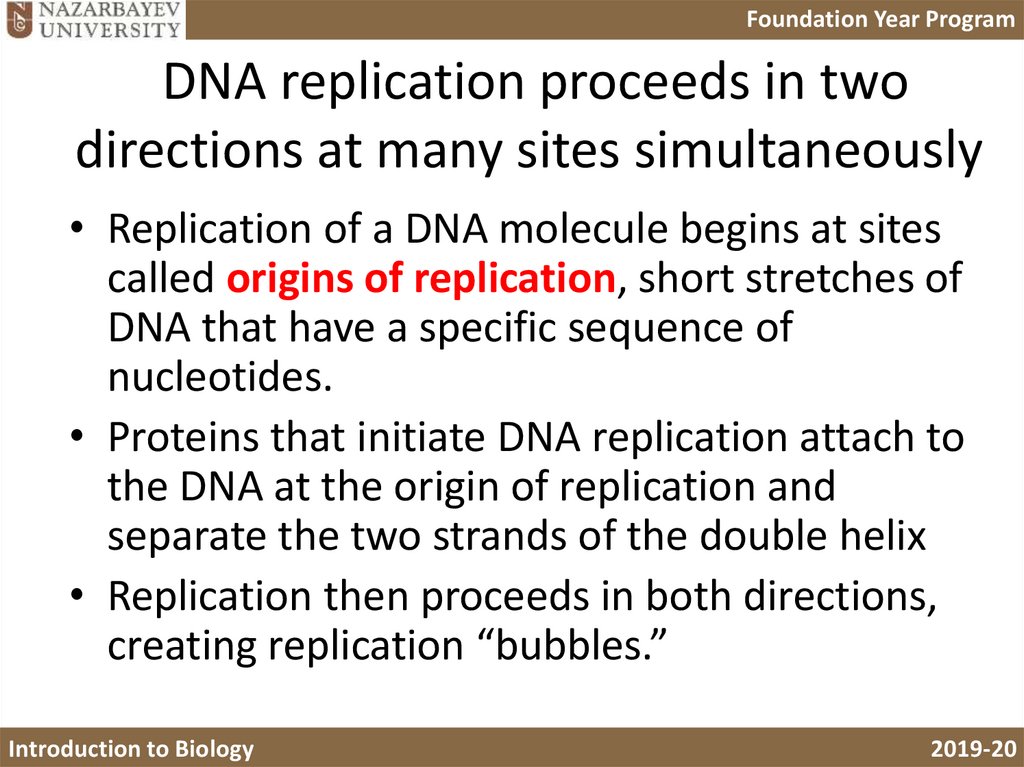
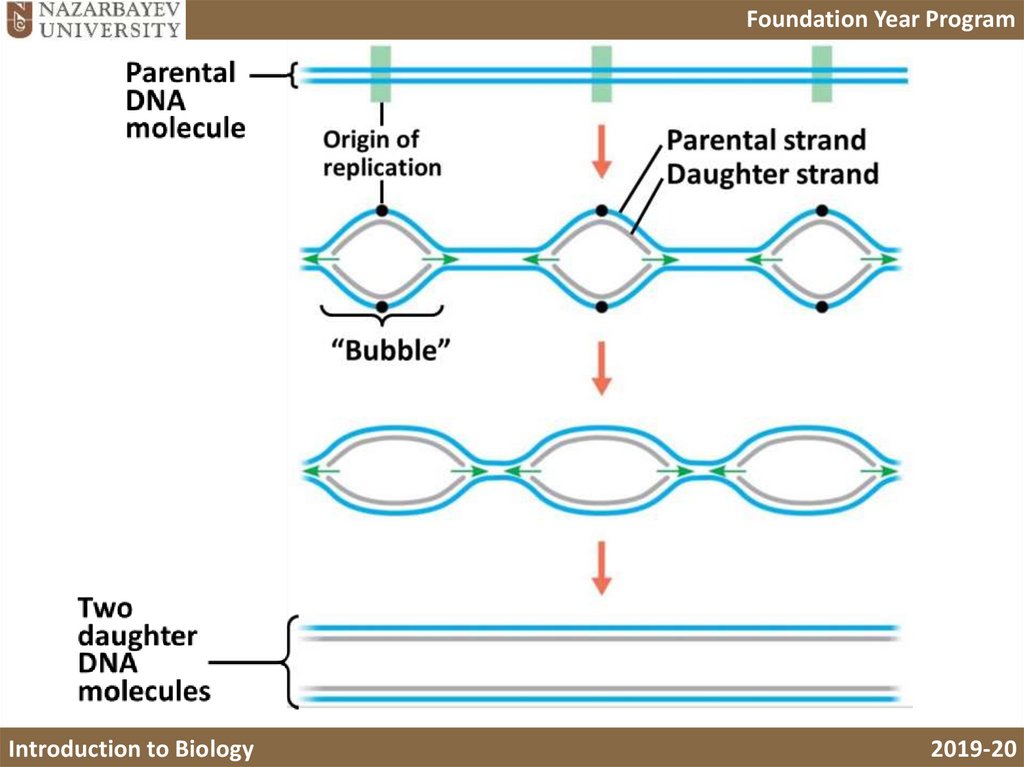

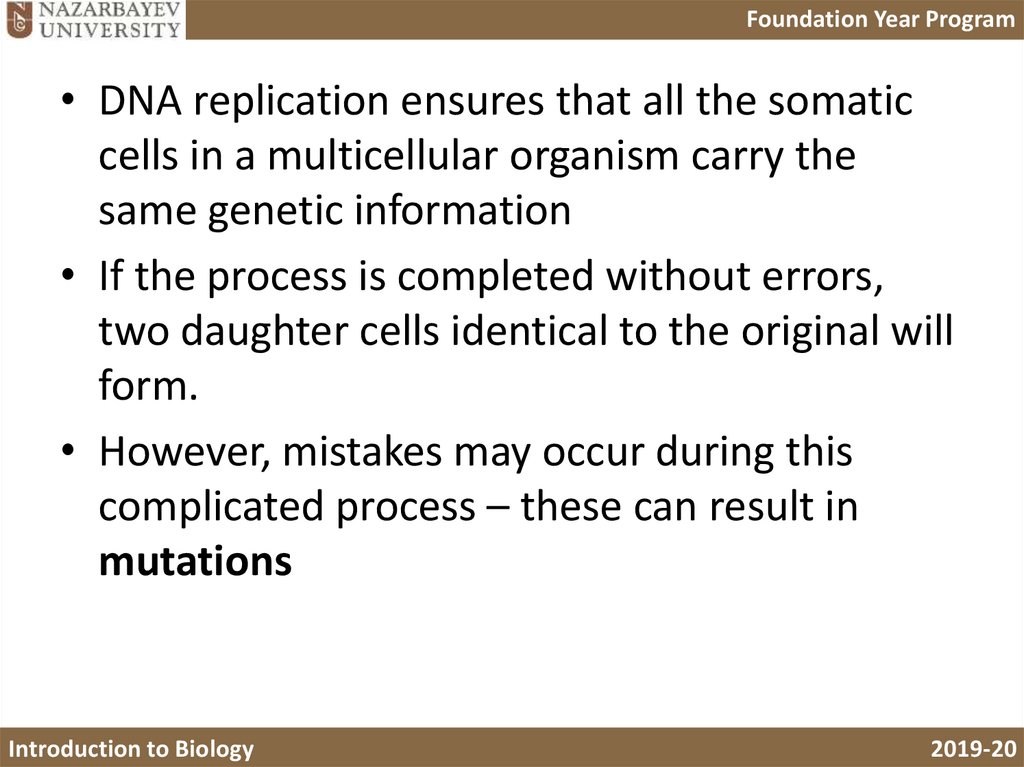
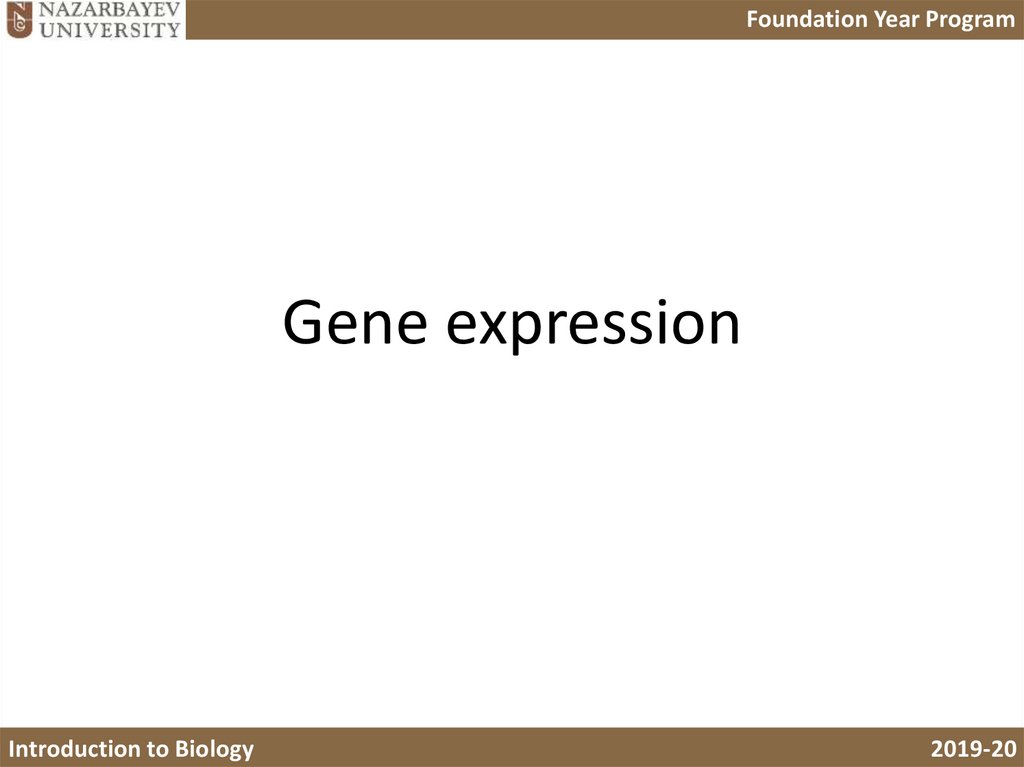
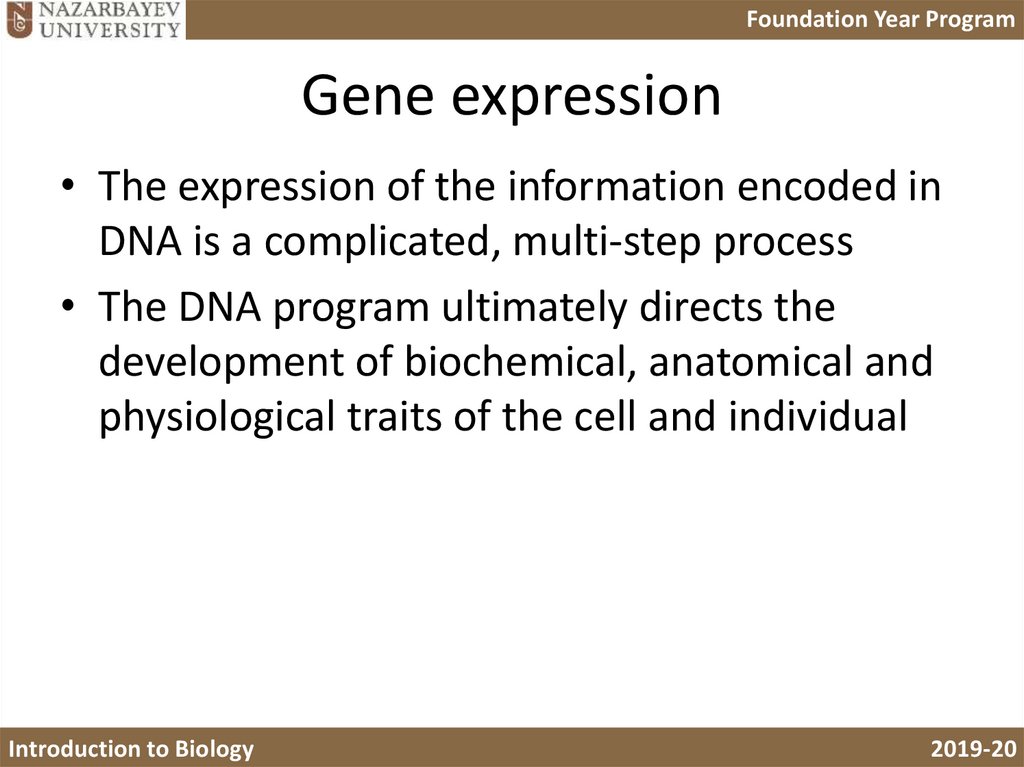
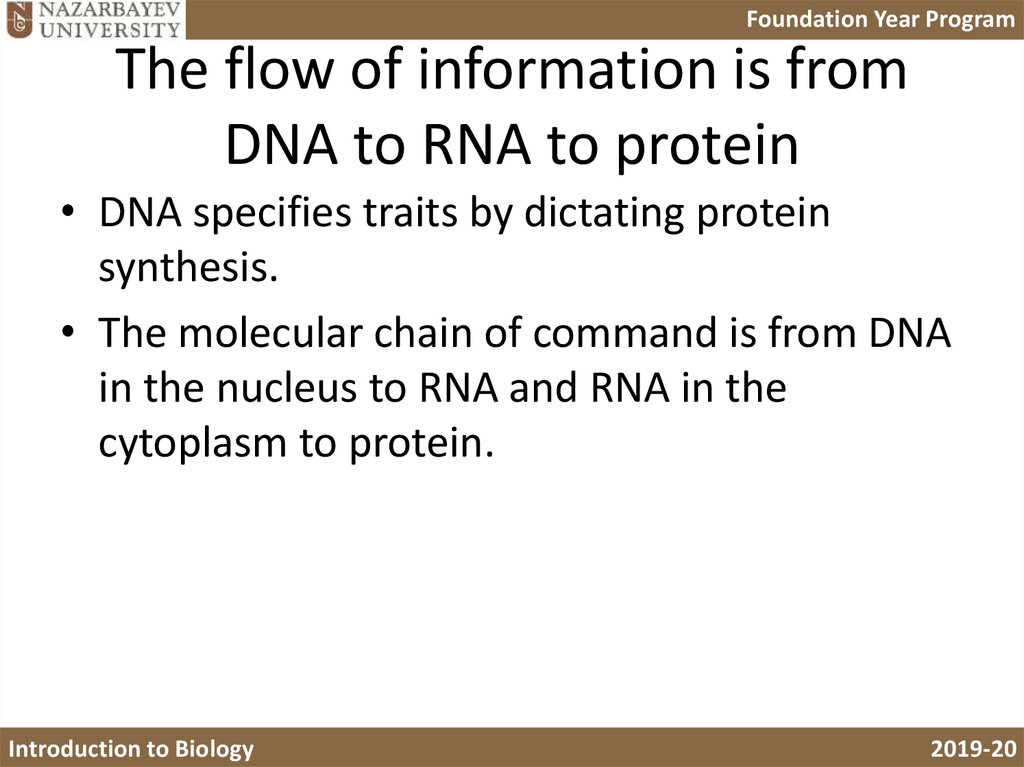

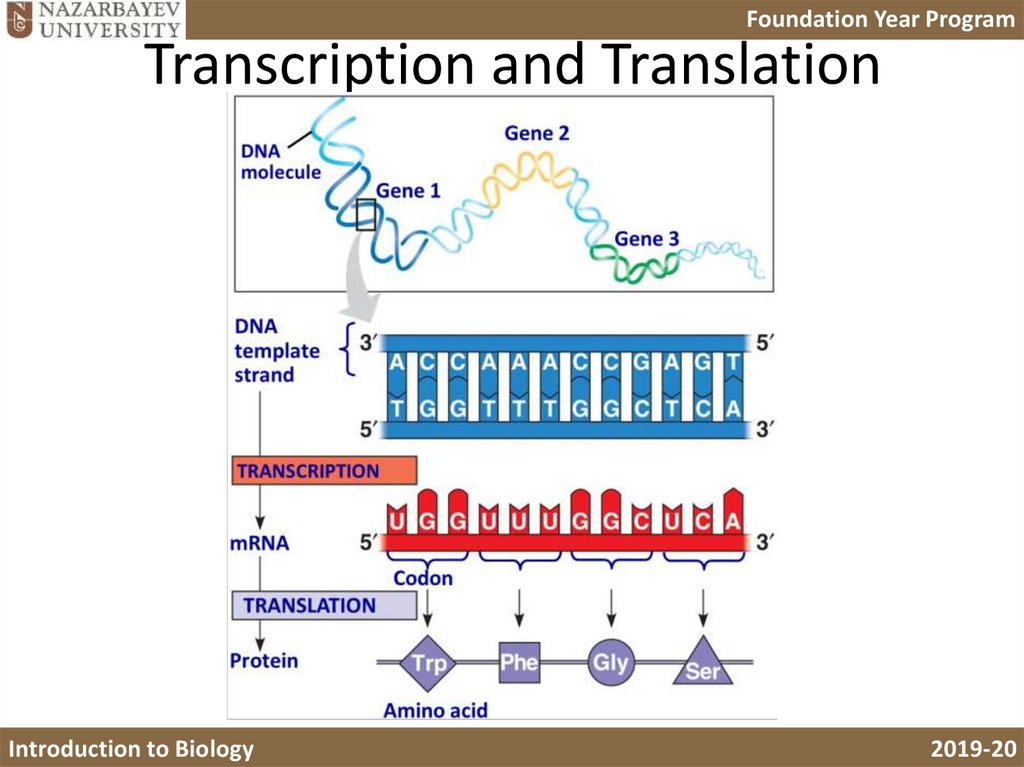
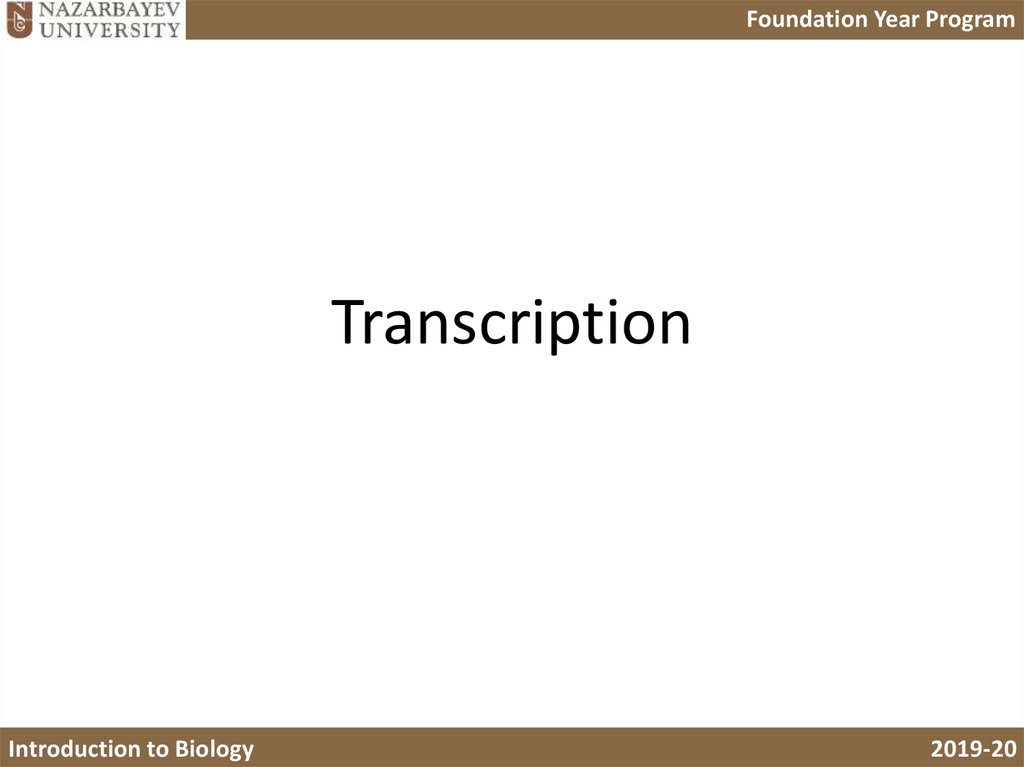
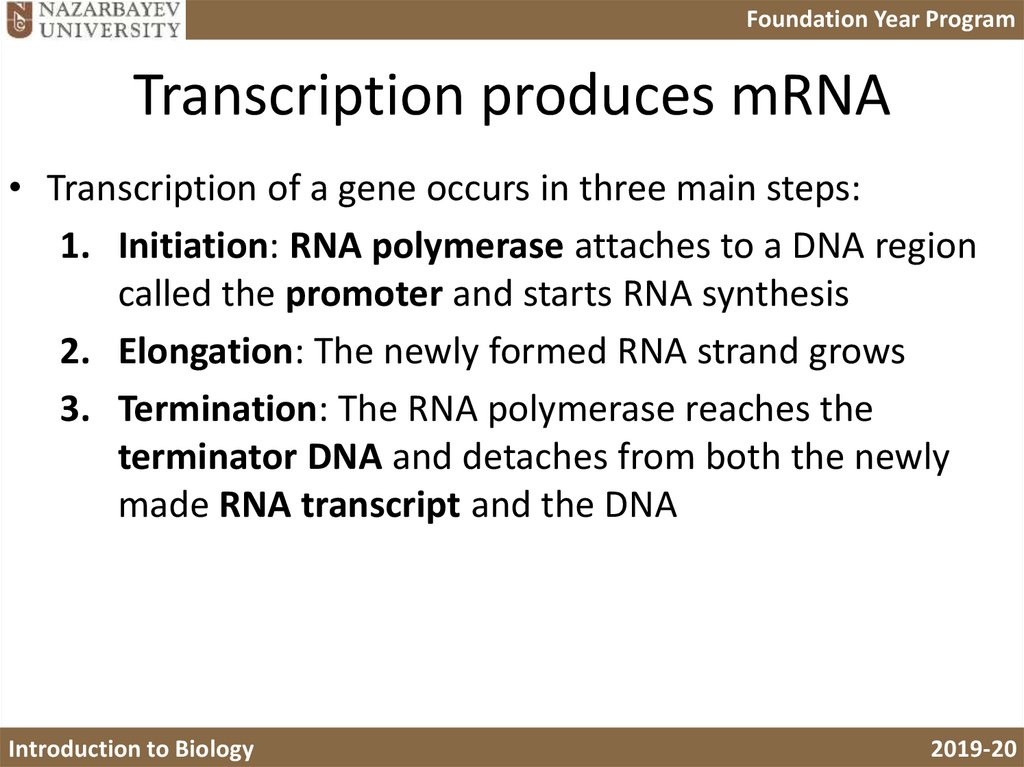
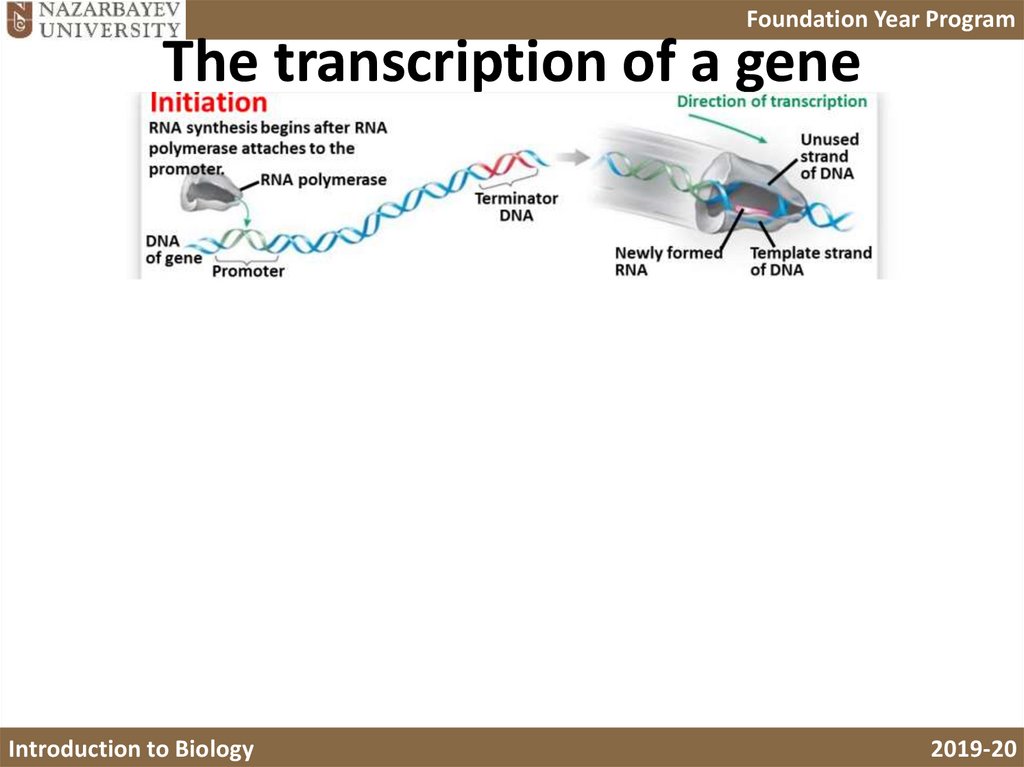
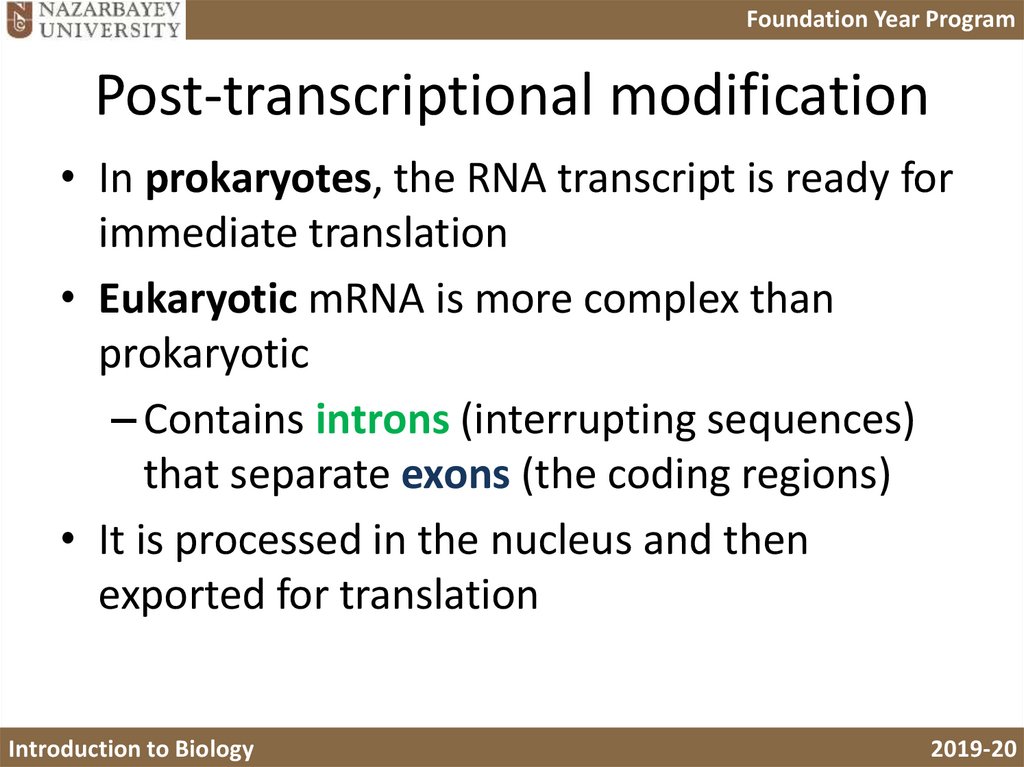
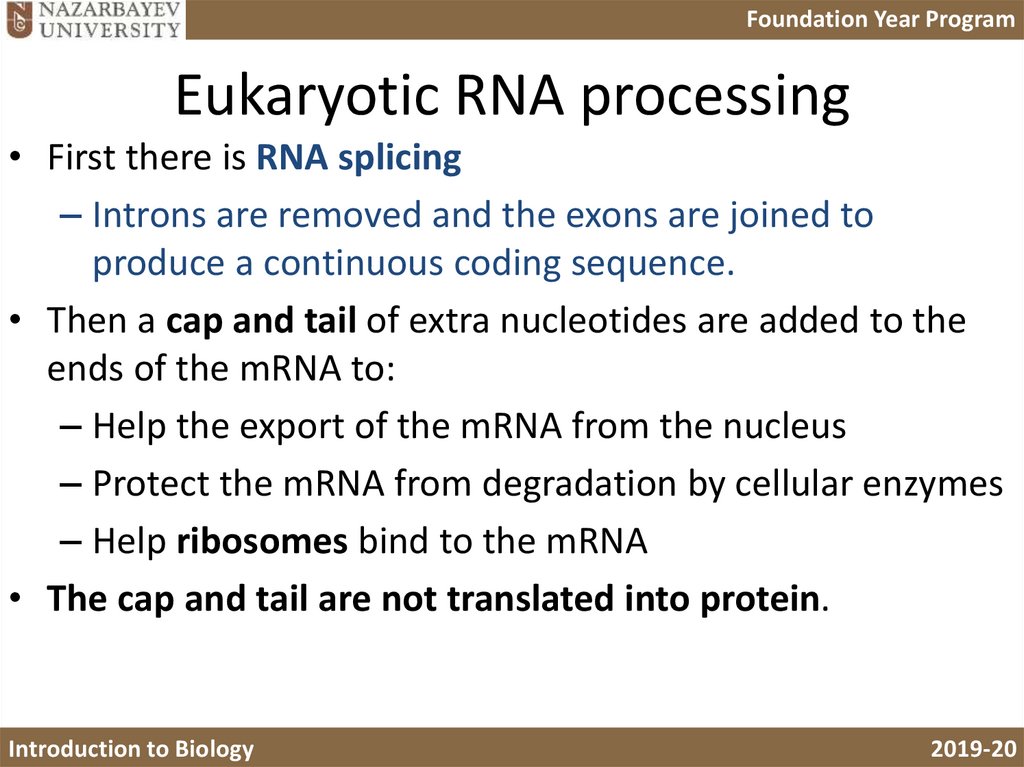
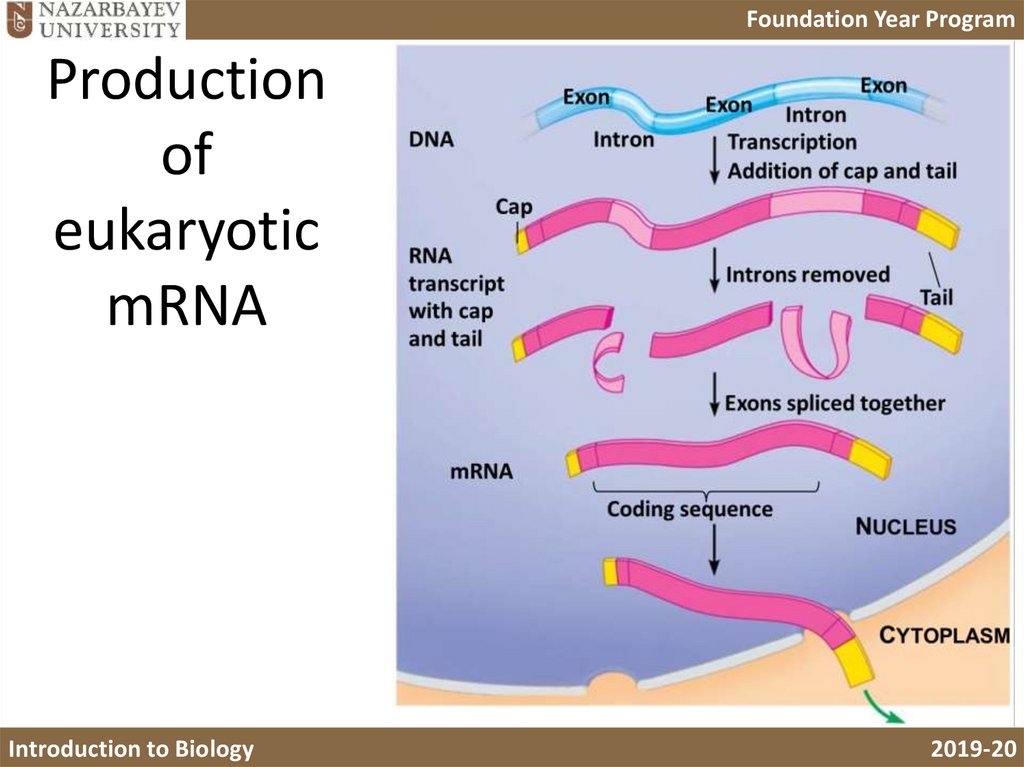
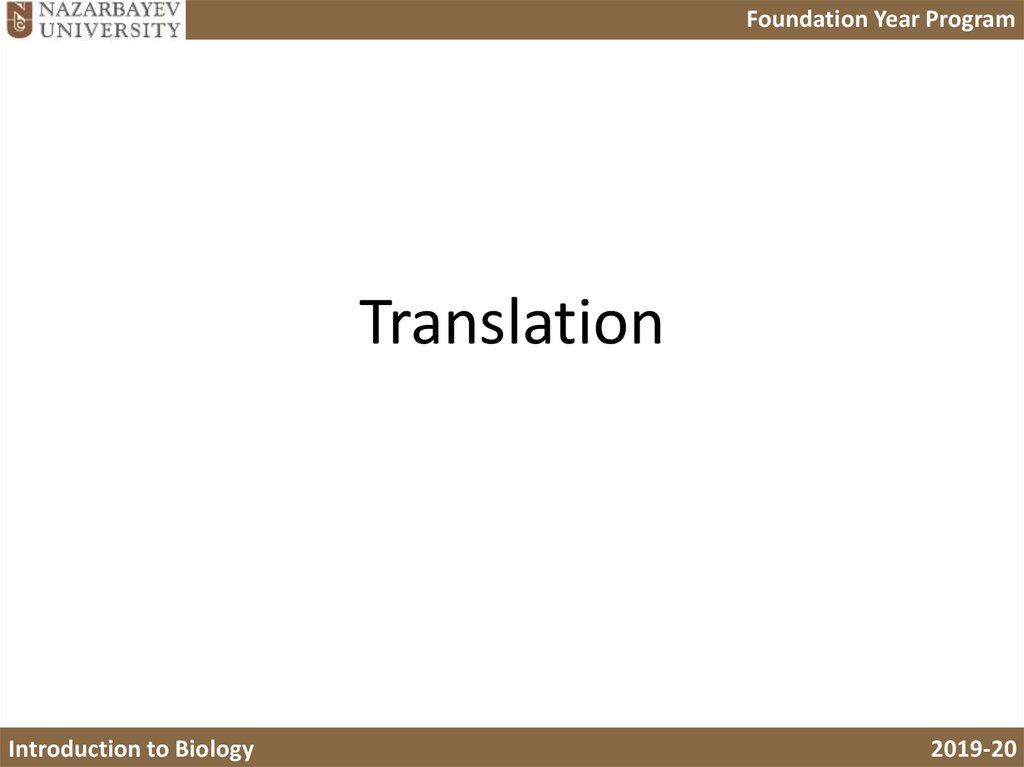

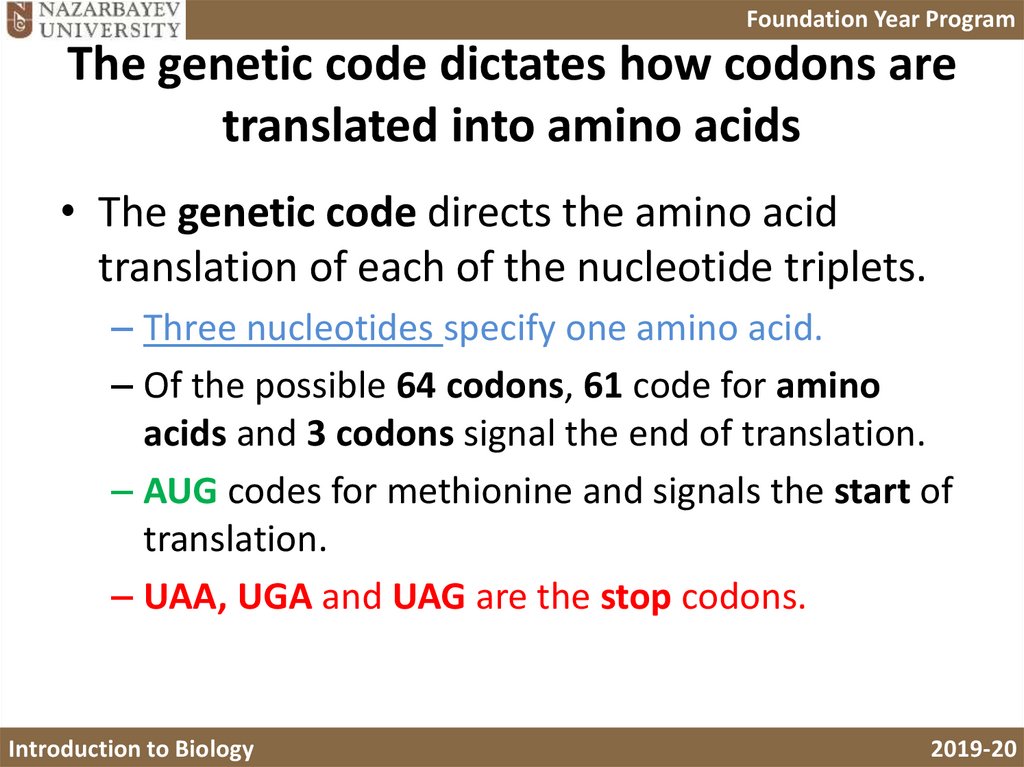
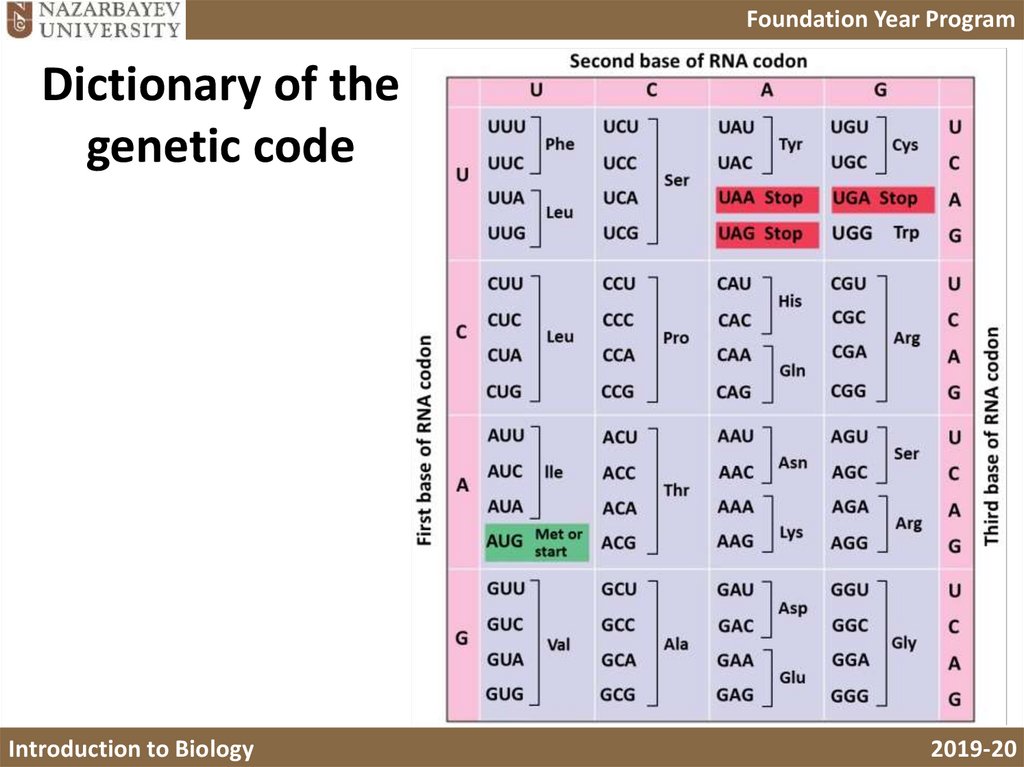
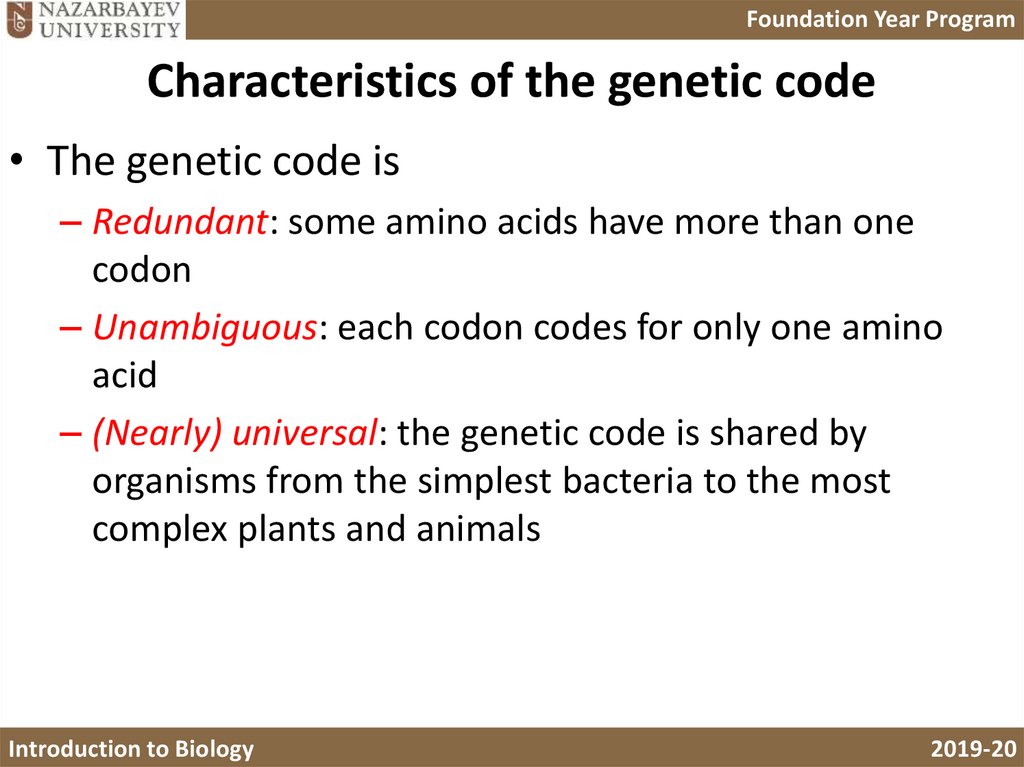
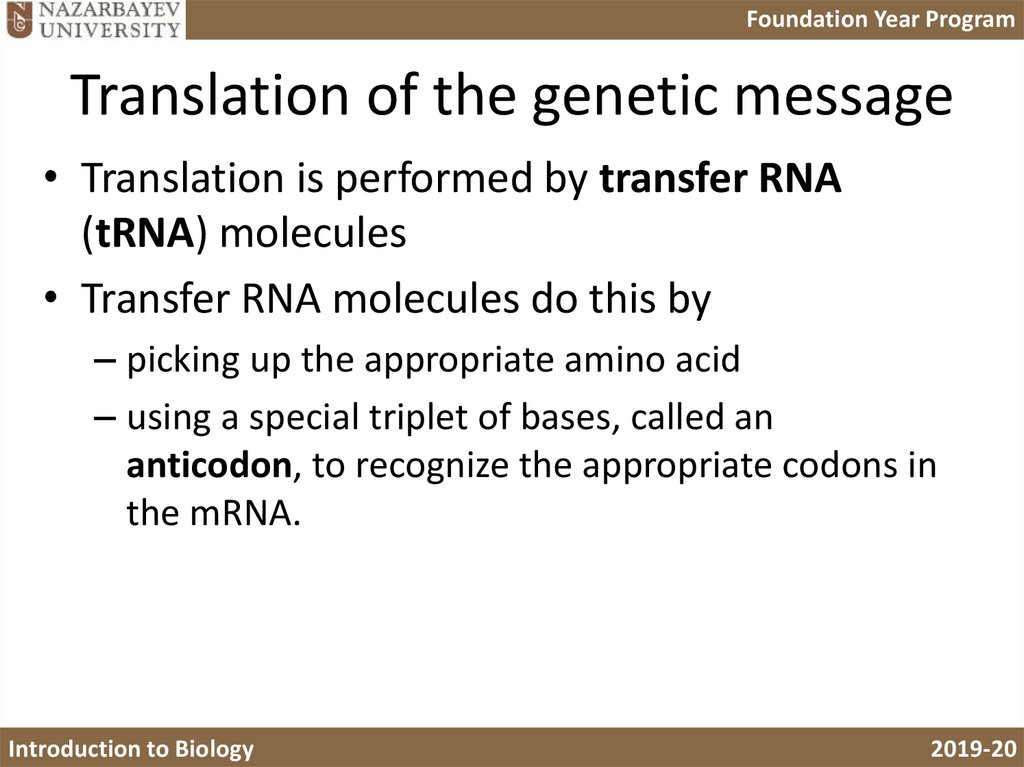
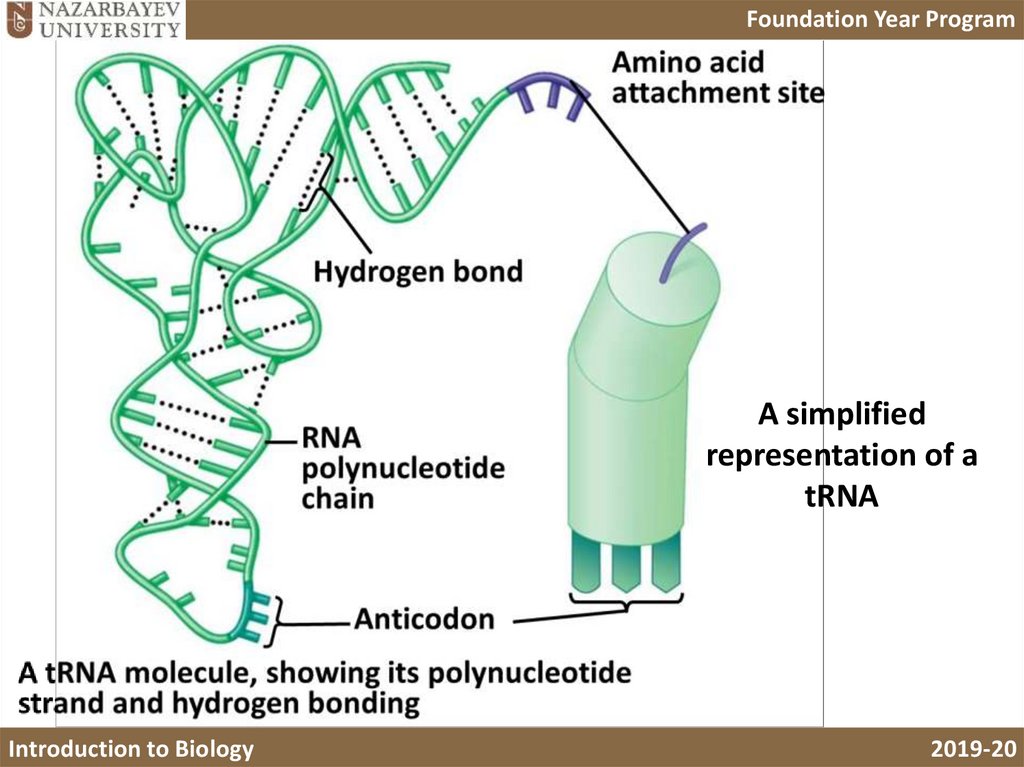
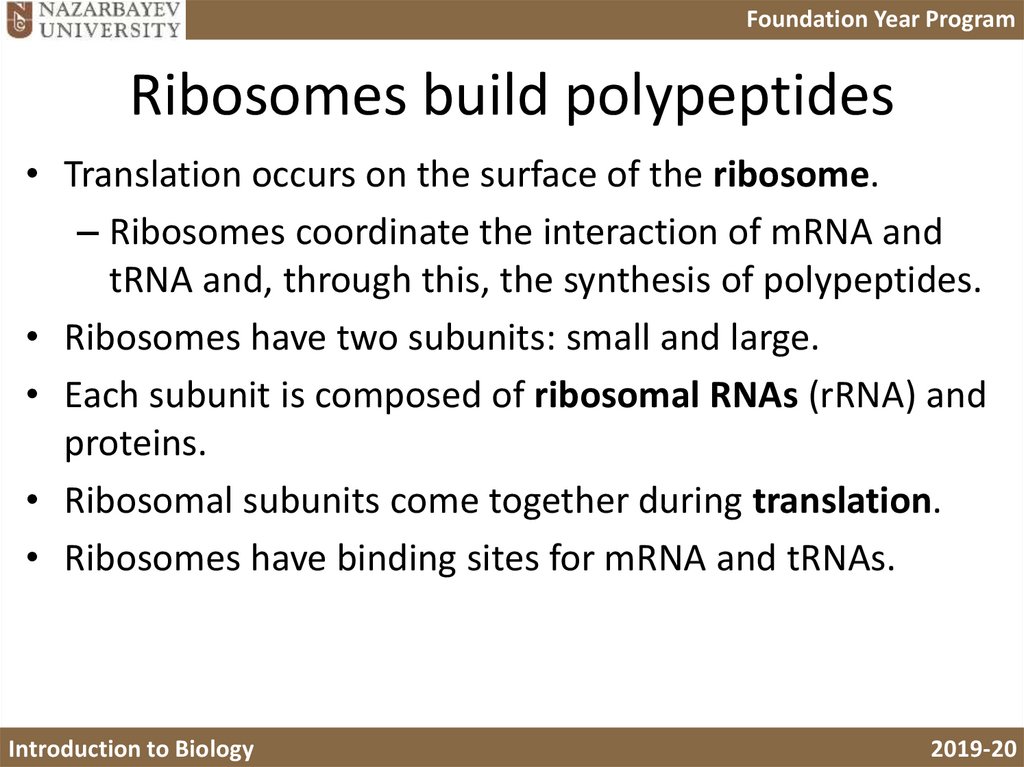
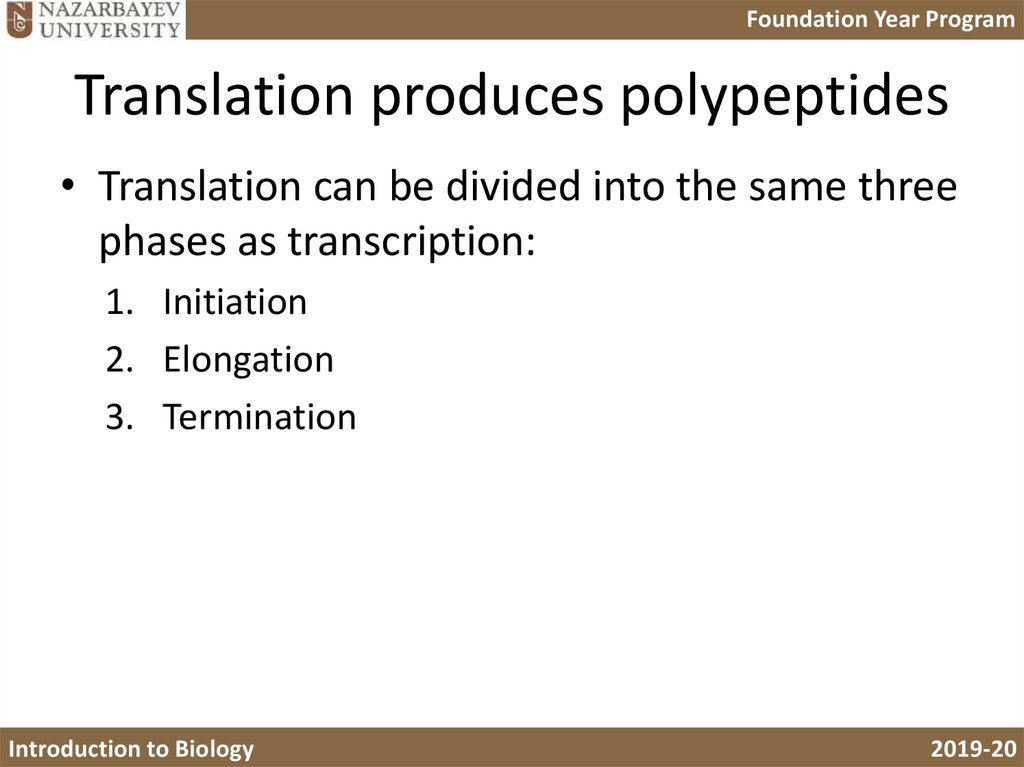
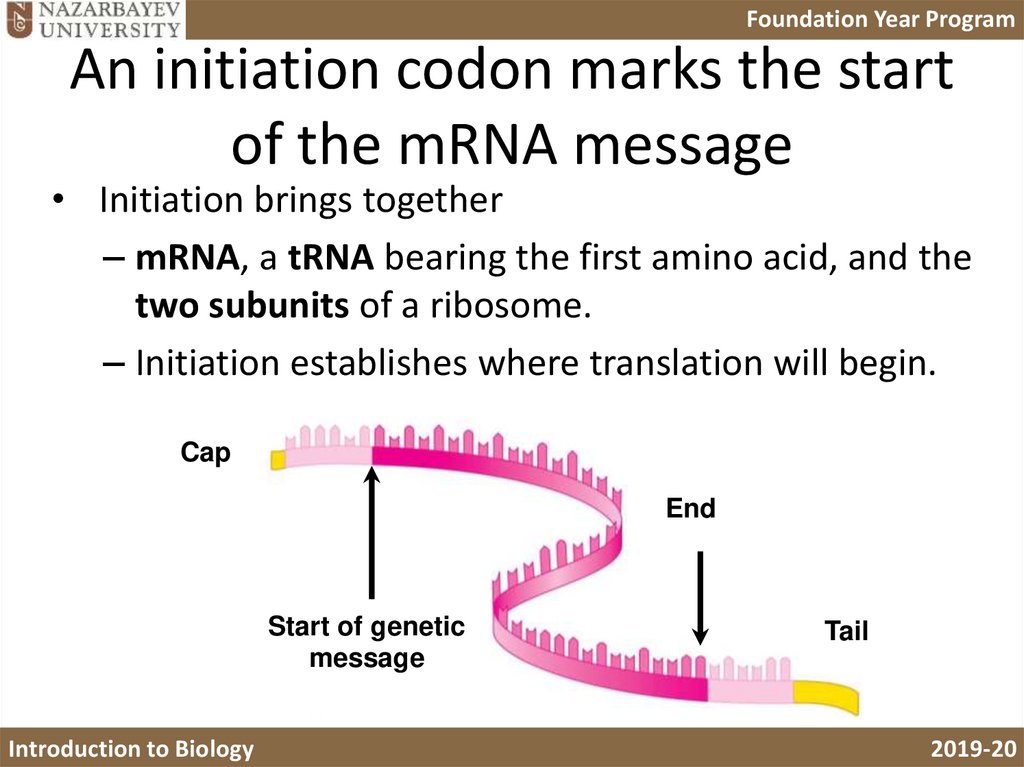
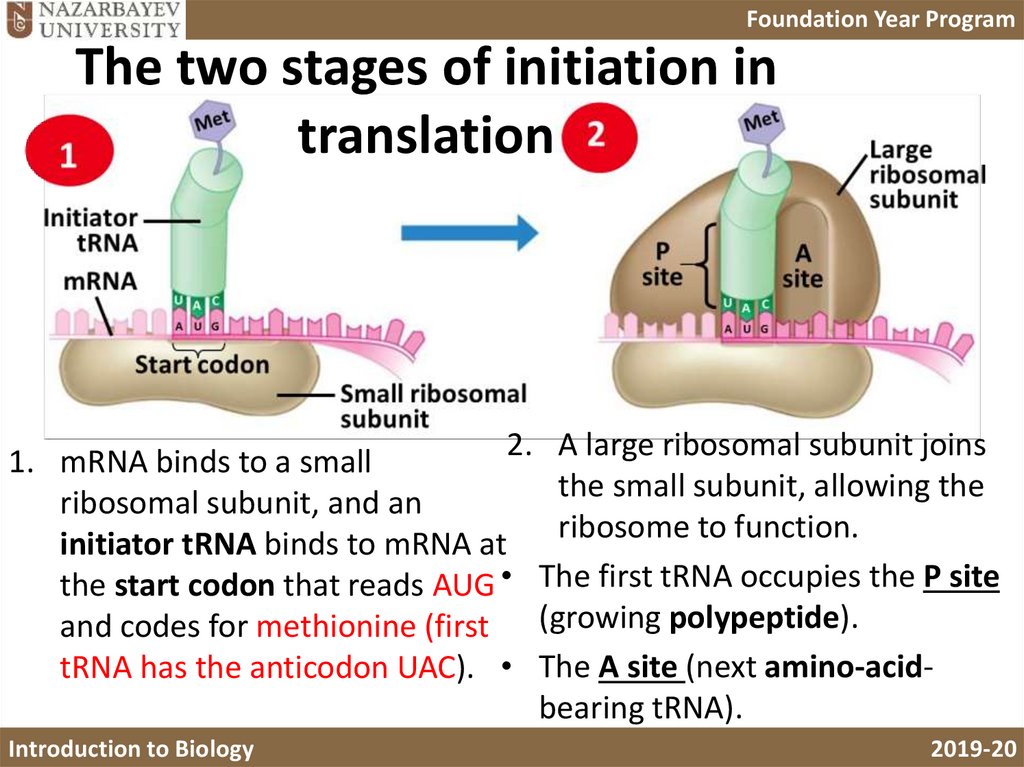
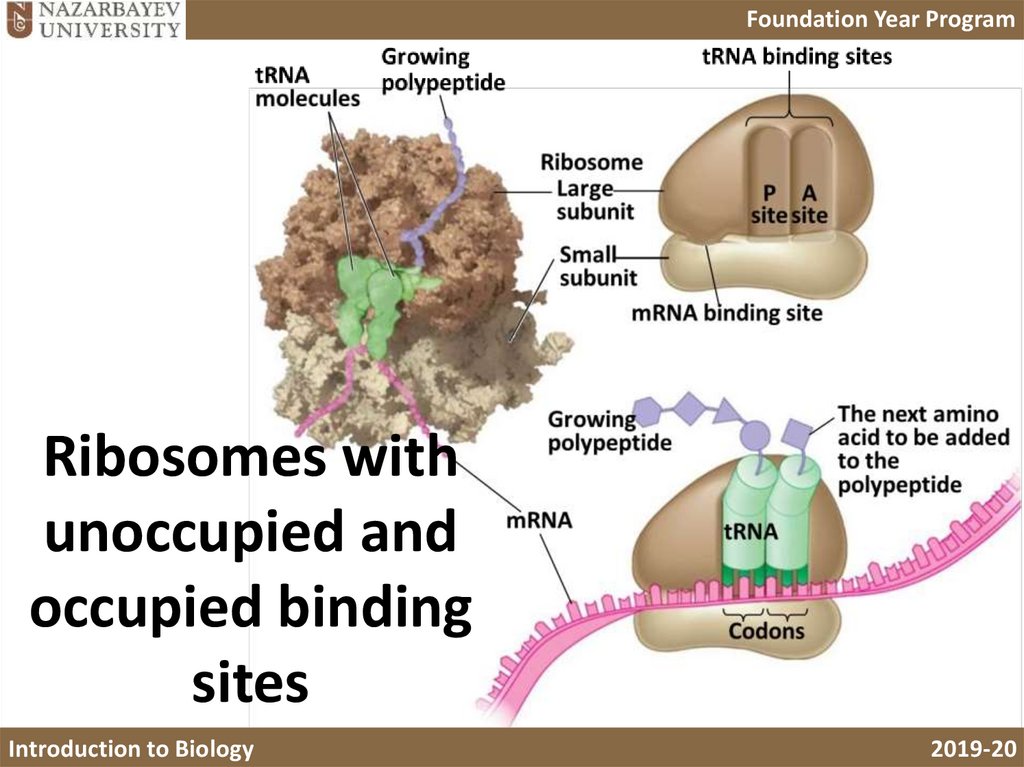
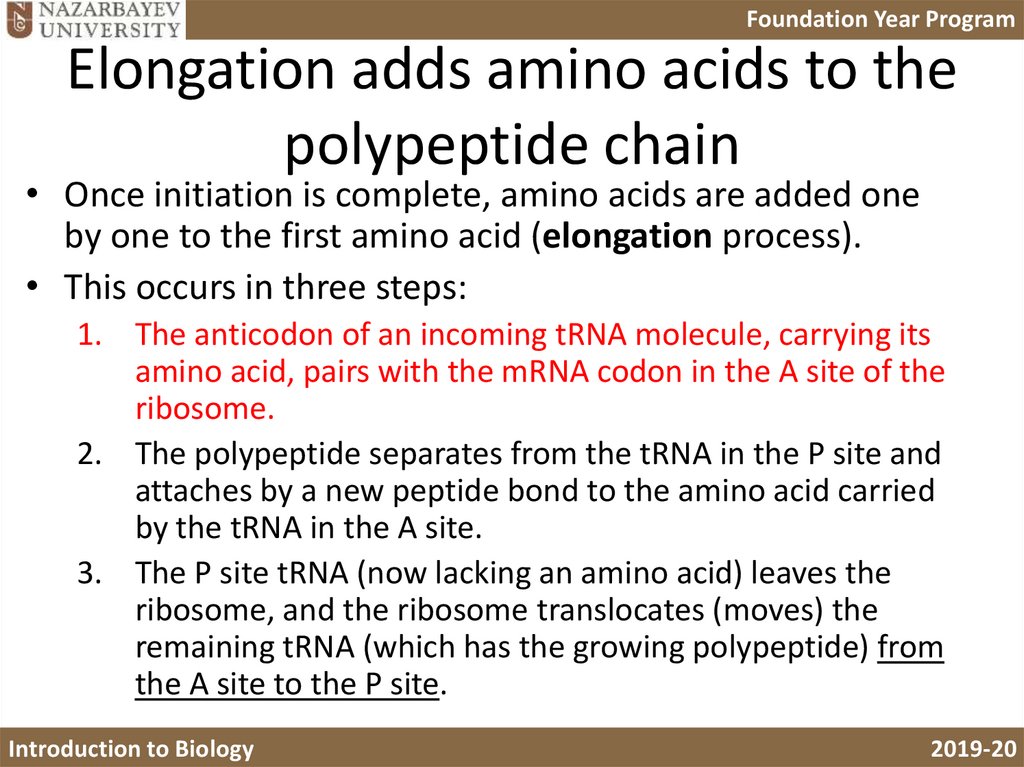
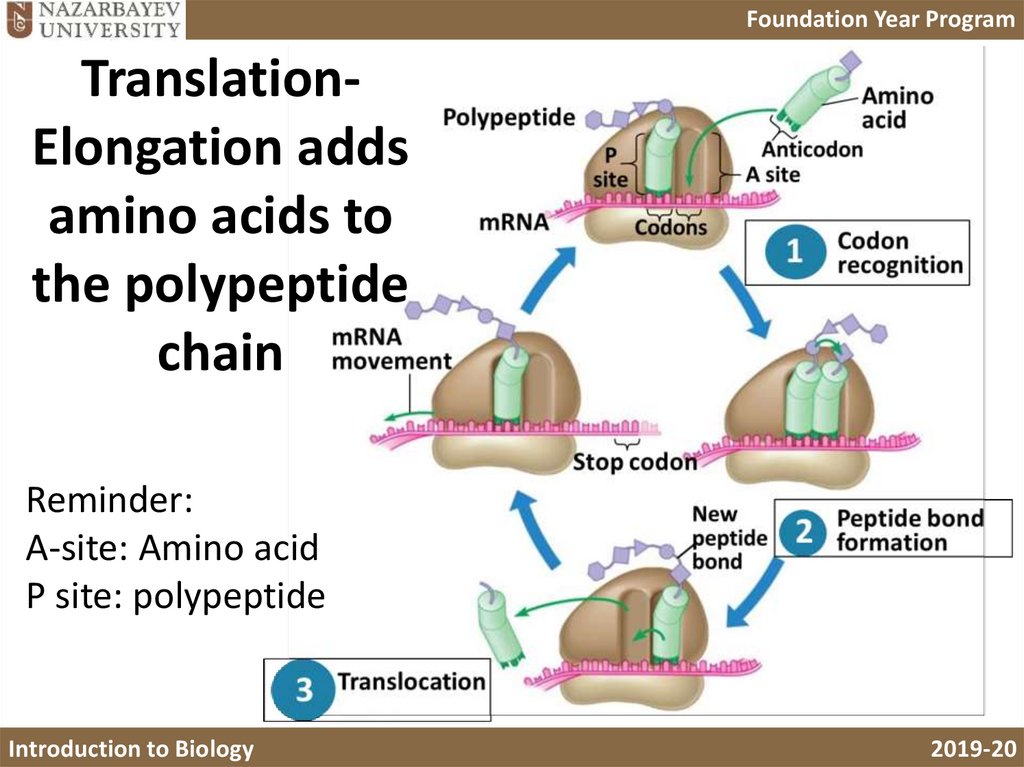
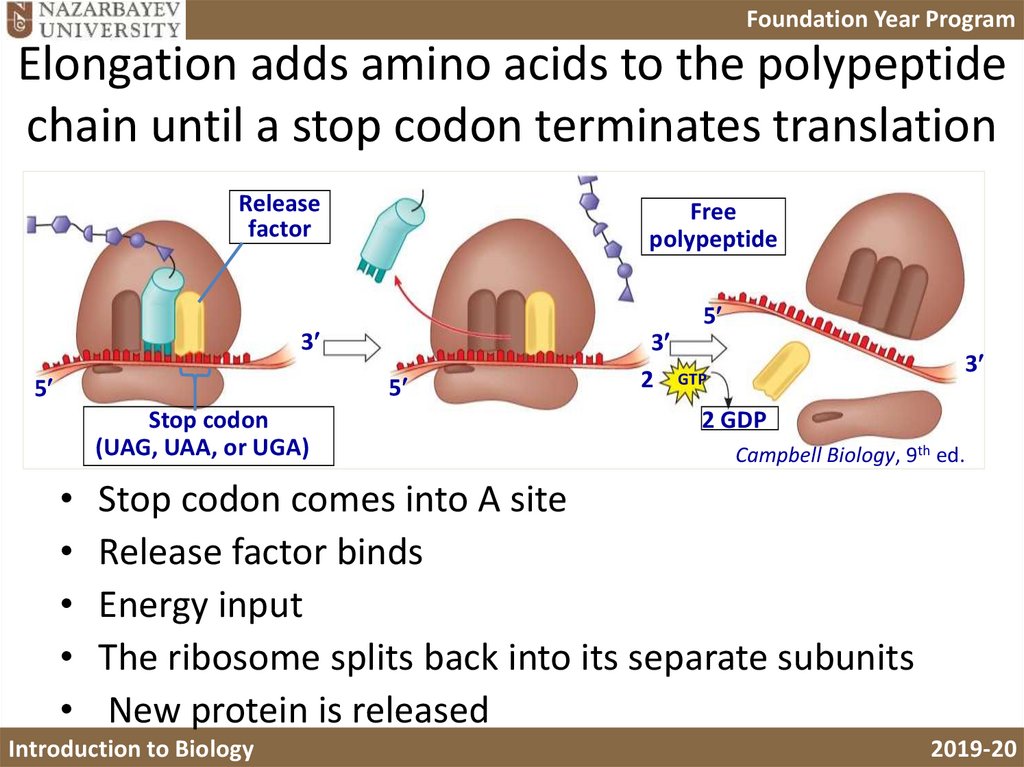
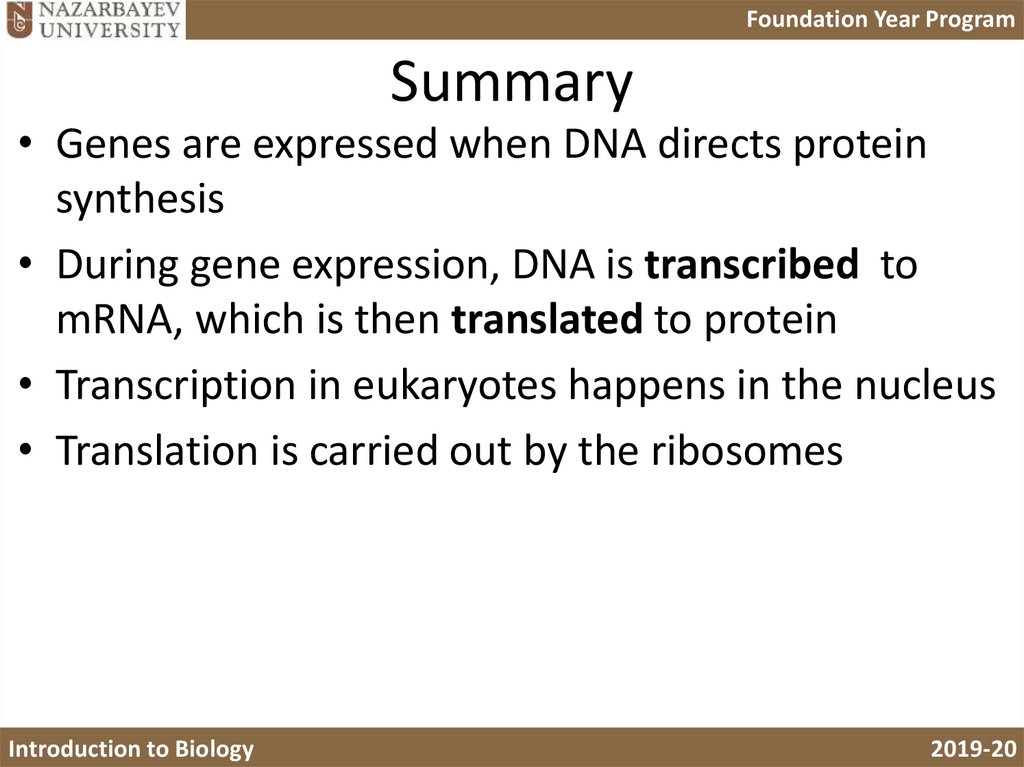
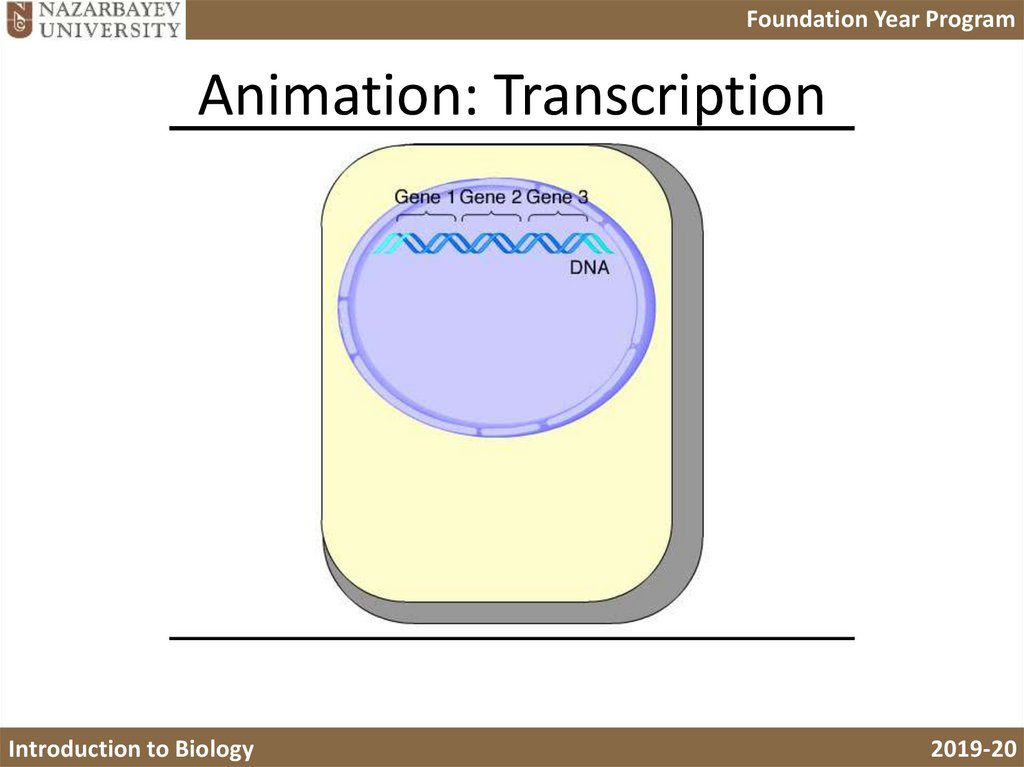
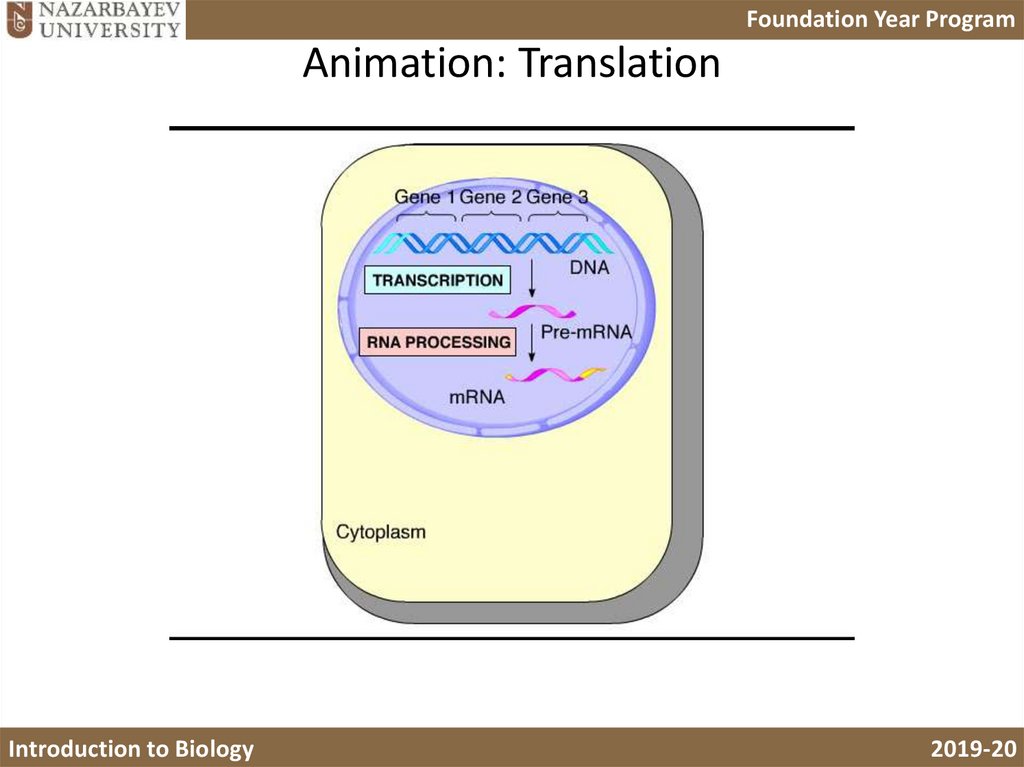
 biology
biology








